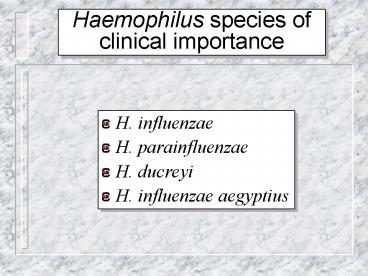Haemophilus species of clinical importance - PowerPoint PPT Presentation
1 / 15
Title:
Haemophilus species of clinical importance
Description:
Runny nose, low grade fever, headache ... Gram-negative coco-bacilli in CSF (in 80% of meningitis cases) H. influenzae-b: diagnosis ... – PowerPoint PPT presentation
Number of Views:820
Avg rating:3.0/5.0
Title: Haemophilus species of clinical importance
1
Haemophilus species of clinical importance
- H. influenzae
- H. parainfluenzae
- H. ducreyi
- H. influenzae aegyptius
2
Haemophilus influenzaeage dependence
3
Haemophilus influenzaeseasonal variation
4
Decline in Haemophilus influenzae infections
5
Haemophilus affected organs
6
Haemophilus a Gram negative bacillus
- A Gram negative bacillus
- Grows of chocolate agar with factors X (hemin)
V (NAD)
7
H. influenzae-bsymptoms
- Runny nose, low grade fever, headache
- Septicemia septic arthritis, conjunctivitis,
cellulitis, epiglotitis, meningitis, convulsions,
coma - Airway obstruction suffocation
8
H. influenzae-bsecondary complications
- Loss of hearing and learning disabilities (mental
retardation)
9
H. influenzaenon-b strains
- Second commonest cause of otitis media among
young children - Pneumonia in adults
10
H. influenzae-bvirulence factors
- Capsule is the major pathogenesis factor it is
antiphagocytic - LPS causes the usual inflammatory and
cardio-vascular symptoms - IgA1 protease may aid mucosal colonization
11
H. influenzae-bdiagnosis
- History and physical examination
- Blood culture (positive in 50)
- PRP (polyribitol phosphate in serum and urine
- Gram-negative coco-bacilli in CSF (in 80 of
meningitis cases)
12
H. influenzae-btreatment
- Cephalosporin is the antibiotic of choice
Early and prompt treatment is essential. Delays
often lead to meningitis, epigloititis and death.
If the patient does survives, often there is a
loss of hearing and mental and retardation.
13
Haemophilus ducreyi
- causative agent of chancroid
- 5,000 cases per year in the US
- Endemic in areas of Africa and Asia
- Commonest cause genital ulcer in sub-Saharan
Africa
14
Haemophilus ducreyi
- Gram negative bacillus
- Grows of chocolate agar with factors X (hemin)
but not factor V (NAD)
15
Haemophilus influenzae aegyptius
- An opportunistic infection
- can cause conjunctivitis, fever and vomiting
(Brazilian purpuric fever) in children - Grows under the same conditions as H. influenzae































